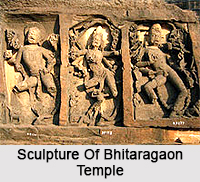 The Bhitaragaon temple dates back to the Gupta Empire. The sculpture of Bhitaragaon temple reflects the artistic genius of the sculptors and craftsmen. In fact it is considered a masterpiece from the art and architecture of Gupta period. The temple has been consecrated in mud mortar and the outer walls of the temple have been decorated by the intricate sculptures and terracotta panels. The main feature of the temple is that it is made out of brick and rises to a height of 15.41 meters.
The Bhitaragaon temple dates back to the Gupta Empire. The sculpture of Bhitaragaon temple reflects the artistic genius of the sculptors and craftsmen. In fact it is considered a masterpiece from the art and architecture of Gupta period. The temple has been consecrated in mud mortar and the outer walls of the temple have been decorated by the intricate sculptures and terracotta panels. The main feature of the temple is that it is made out of brick and rises to a height of 15.41 meters.
The architecture of the temple comprise of the garbhagriha and a porch in the interiors. The sanctum sanctorum of the temple is incomplete as its upper chamber was destroyed by lightning in the 18th century. Another important feature of this temple is that it is the first temple with a shikhara that was constructed in 600 AD. The recesses created on the outer walls of the temple are quite impressive.
As far as the interior sculpture of Bhitaragaon temple is concerned it is primarily simple. But the outer walls have been ornamented with intricate carvings on the bricks. The importance of the quaint sculpture of Bhitaragaon temple lies in the fact that it is one of the earliest examples of temple architecture.



















